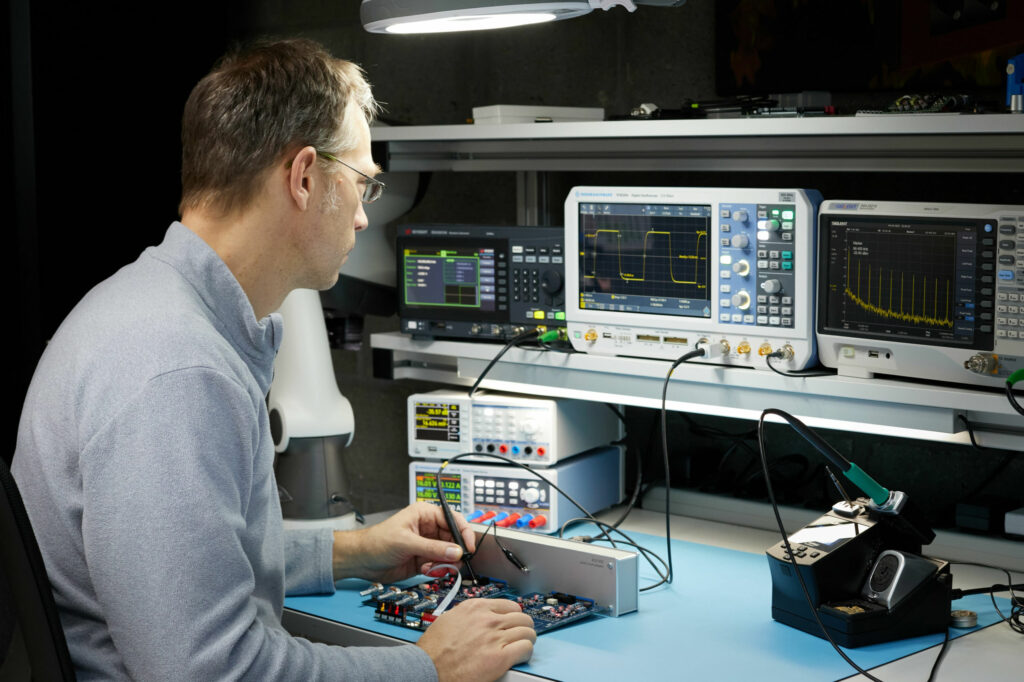
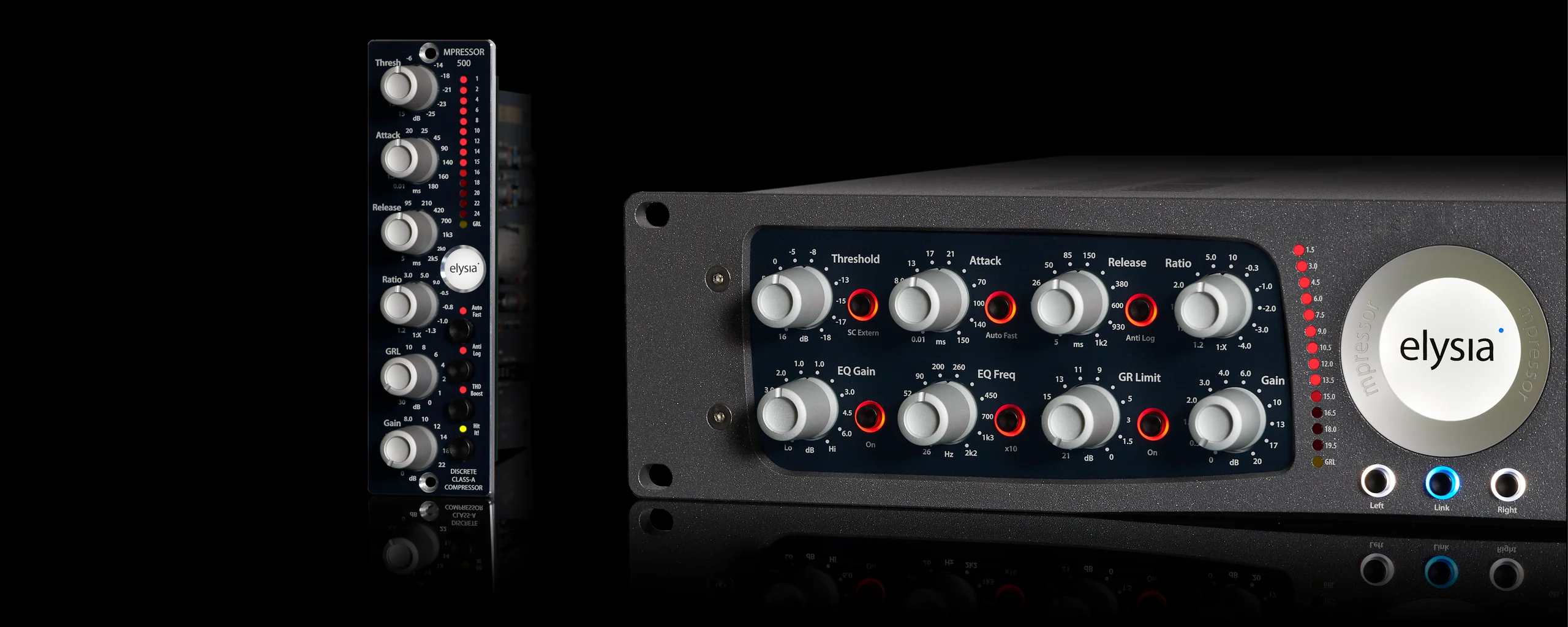

By loading the video, you agree to YouTube's privacy policy.
Learn more

By loading the video, you agree to YouTube's privacy policy.
Learn more

By loading the video, you agree to YouTube's privacy policy.
Learn more

By loading the video, you agree to YouTube's privacy policy.
Learn more

By loading the video, you agree to YouTube's privacy policy.
Learn more
mpressor gets you creative sounds that make your mixes stand out!
Choose between different examples including applications like recording, mixing or even mastering, use good headphones or speakers. Just press Play and A/B between the bypassed and active sounds!
Note: All audio is being processed by the analog hardware device.
Featured artists in these examples: GiveUsAnimalNames
Note: If you have technical difficulties and don't hear audio playing back, you may want to switch off silent mode on your mobile device.
It is characteristic of a logarithmic release that the time constant shortens when the amount of gain reduction increases. The advantage of this behavior is that short and loud peaks (e.g. drums) have a fast release time, while the remaining material is processed with a slower release time.
But if intentionally striking and creative compression is the goal, it definitely makes sense to turn things upside down. In the Anti Log mode of the mpressor the curve behaves just the other way round: If the threshold value is passed and compression starts, the release time will be longer at the beginning. If the input signal starts to decline, however, the release time will become faster as a result.
Choosing the right time settings is very important, but depending on the dynamic progress of the source material this can be a difficult task – no matter if single tracks or complete mixes are processed. If a very short attack time is chosen, the compressor is able to catch the short peaks, but on the other hand the sustaining signal will also be processed, which might result in audible distortion. Longer settings reduce distortion significantly, but then the compressor is too slow for catching fast impulses. This is where the Auto Fast function comes into play. For example, if you set the attack to 80 ms and then engage the Auto Fast mode, the attack time will be shortened automatically on fast and loud signal impulses. The compressor reduces the signal quickly and prevents it from slipping through.
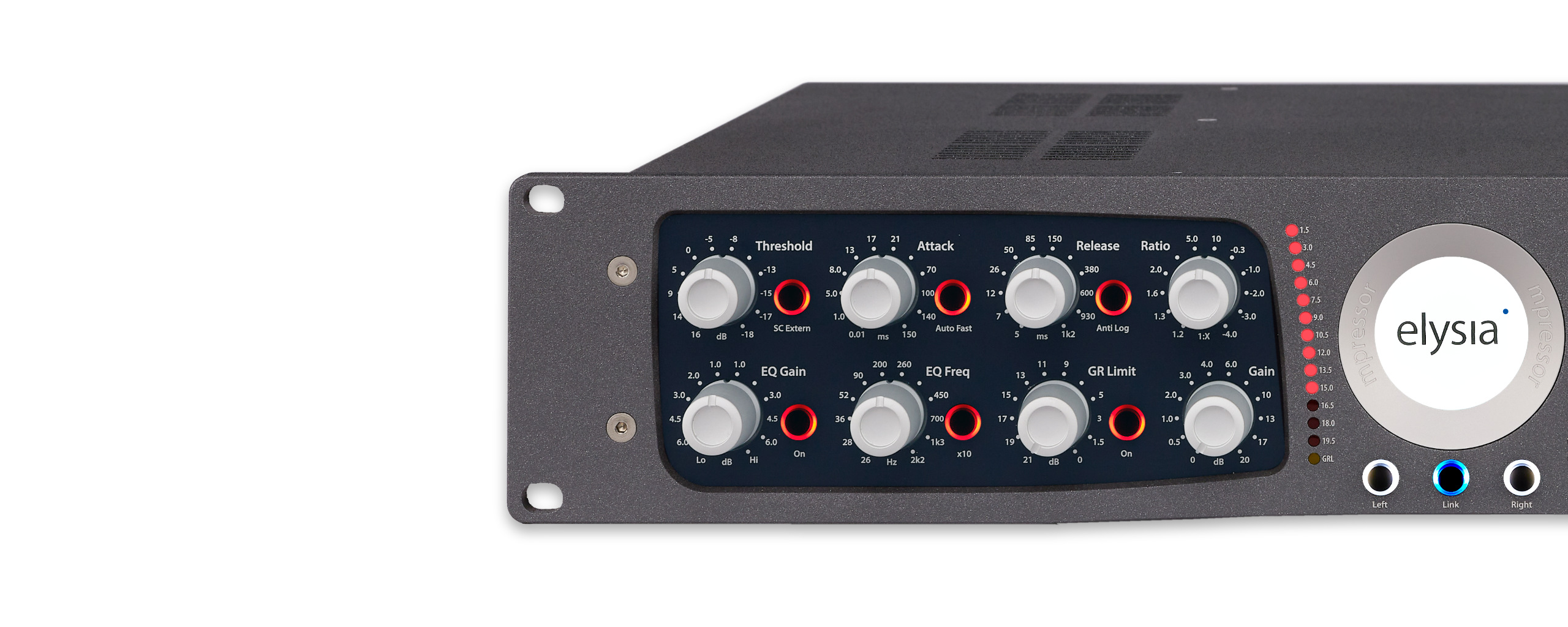
Negative ratios – what exactly does this mean? To get a better understanding of this function, it makes sense to realize what the ratio control of a ‘normal’ compressor does:
At a negative ratio, the characteristic curve bends and returns back down after crossing the threshold. The louder the input signal, the lower the output signal – perfect for groovy compression effects. To get a grip on the extreme ‘destruction’ this can cause, engaging the Gain Reduction Limiter is just the right idea.
The external sidechain enables the compressor to control its processing totally independent from the audio material running through it. If the SC Extern switch is active, compression will not be triggered by the signals from the regular audio inputs anymore, but by different signals which are fed into the additional sidechain input connectors.
If, for example, a duplicate of the input signal is processed with an equalizer and then fed into the sidechain input, the result will be frequency-dependent compression. Another example is to send the bass drum of a drum machine into the sidechain input in order to achieve nice groovy compression that is pumping in sync with the music.
The external sidechain inputs are equipped with a high pass filter that has its cut-off frequency at 80 Hz with 6 dB per octave. This has been done in order to reduce the influence of the low frequencies on overall compression by a certain amount in order to keep the effect as balanced as possible.
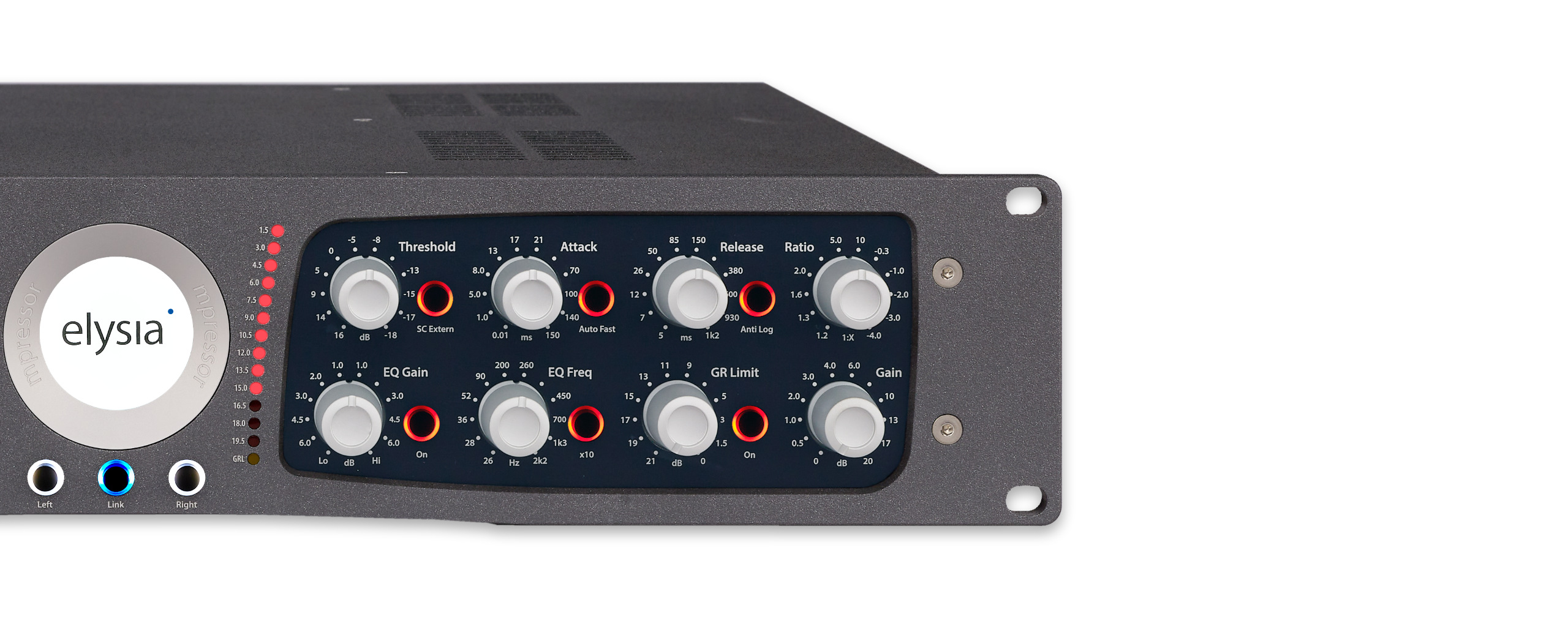
This limiter is not placed in the audio path where you would usually find it, but in the control path of the compressor. When it is activated, it limits the control voltage according to the setting of the GR Limit controller. This means: No matter how high the input level might become – the amount of gain reduction will never exceed the value which you have set.
For comparison, imagine a fader on a mixing console with your hand moving the fader to ‘play compressor’. If now the fader was limited by a piece of duct tape at -10 dB, for example, it could only reduce the signal up to this value. If the input level dropped below this limit, the fader would be moved up correspondingly.
However, if the input signal got even louder, the fader could not be moved down any further because of the duct tape limit, and then the output signal would become louder again in correspondence with the input signal.
This filter is a specialist in changing the overall sonic character of a signal with ease. It features two controllers per channel and is capable of producing convincing results flexibly in no time at all. Whenever a classic shelving filter would be too limited and a fully parametric filter would be too much, the Niveau Filter is the perfect tool.
Its main function is to change the proportions between high and low frequencies. The principle is quite similar to a pair of scales: Dependent on the gain setting around a variable center frequency, the high frequencies are boosted whereas the low frequencies are attenuated (or vice versa).
By simultaneously boosting and cutting the selected frequency areas, it is much easier to influence the character of a track (‚bright‘ vs. ‚dark‘) compared to using other types of equalizers. The center frequency can be shifted continuously between 26 Hz and 2.2 kHz or between 260 Hz and 22 kHz respectively (when the x10 switch is activated).
A crucial part in the development process of a compressor is to design its control element that reduces the audio signal controlled by voltage. This is also where the main technological concepts show the most obvious differences.
The mpressor uses elysia’s fully discrete and temperature compensated Transconductance Amplifier (TCA). A differential pair of transistors that uses a modulated current source to affect the amount of amplification builds the core of this module. A few extra transistors were added in order to further decrease noise and unwanted influences of the control voltage.
The benefits of discrete electronics design can once again show their strengths by tailoring the sound via the concept of the circuitry and the choice of components. A further advantage of the TCA topology is the very fast response to the control voltage. This is the basis for a compressor that can even handle rapid changes in dynamics and which provides extremely fast time constants.
Some delicate parts of the discrete circuitry can be influenced by the surrounding temperature easily. The main reason for this circumstance is the single transistors that can react very sensitively to variations in temperature (which can – depending on the place of installation and operating time – happen by all means).
With the T12 Heater elysia presents a system that arranges constant conditions and reduces the thermal fluctuation to a minimum. This system was inspired by high-precision measuring instruments. It features up to 12 discrete transistors in a massive copper ring that is warmed up to a definite temperature.
Once the system has reached its working temperature, it only needs little current to keep it at the same level. An electronic control circuit is responsible for a low variance of only a few degrees. The procedure is known from high end tube gear: the mpressor should be granted a short warm-up time to experience it absolute top form.
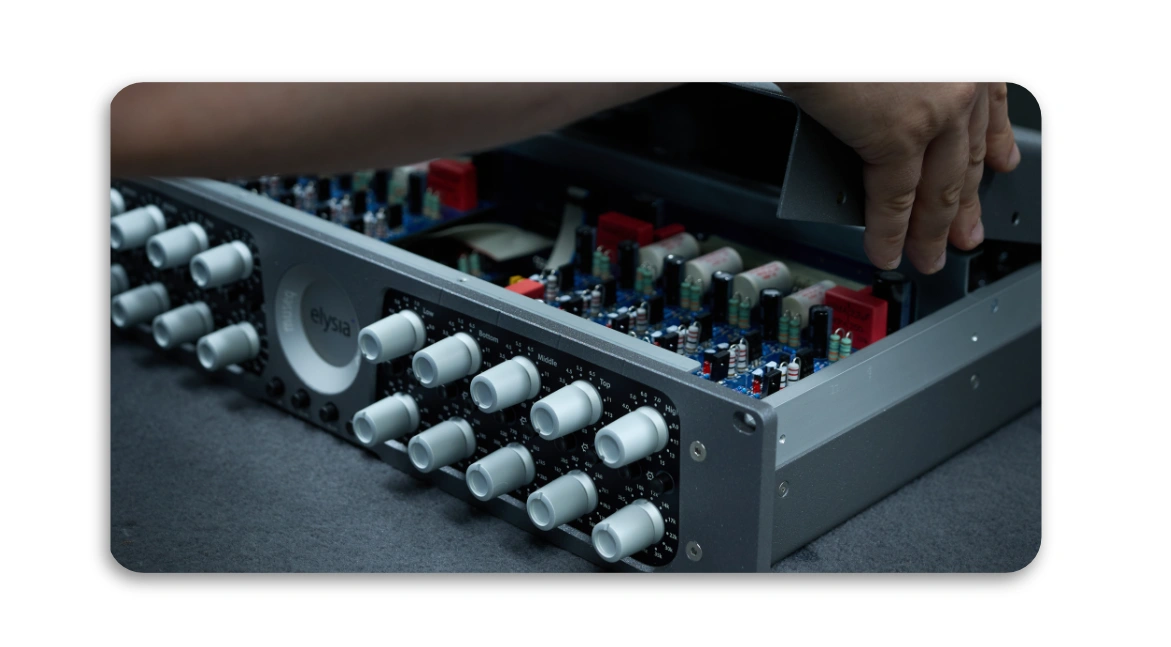
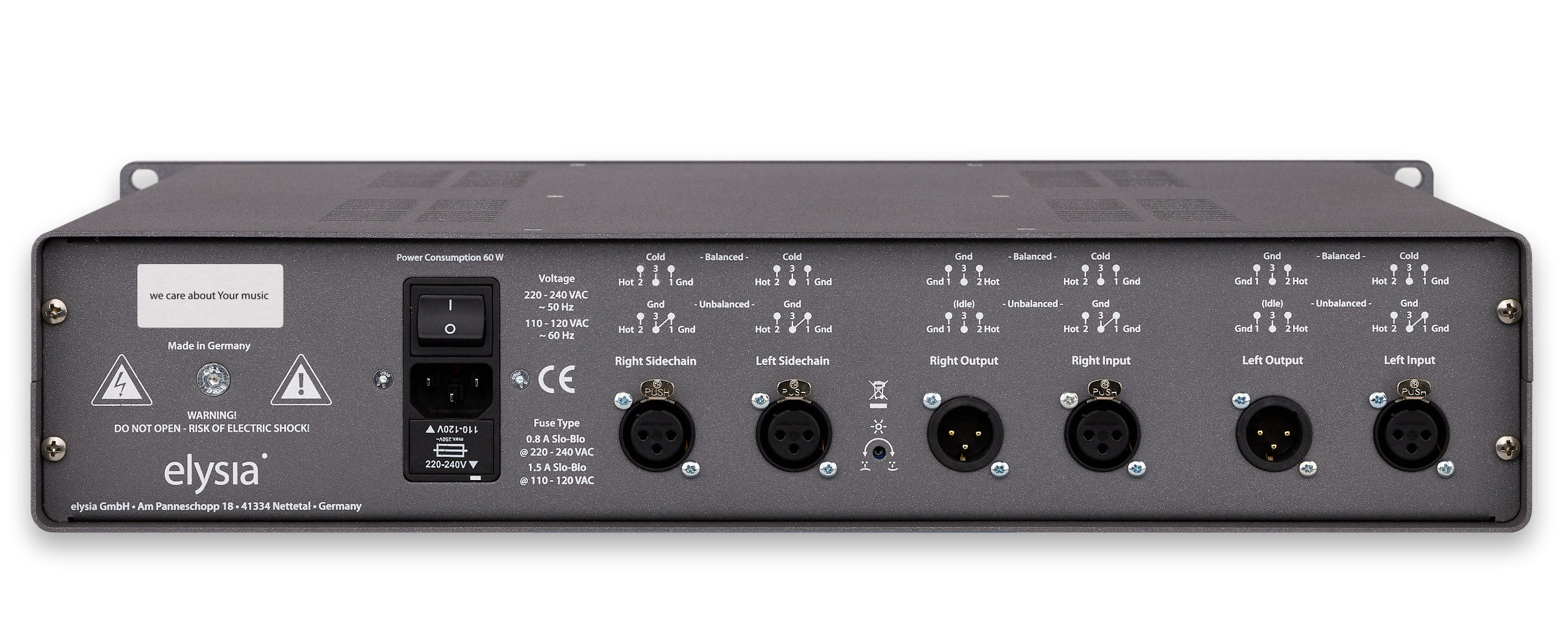
Connecting to mpressor is easy. As a stereo or mono device, there are main XLR inputs and outputs for the left and right channel with a handy Pin-out pattern for balanced and unbalanced cables. With the external sidechain inputs for left and right compression will not be triggered by the signals from the regular audio inputs anymore, but by different signals which are fed into the sidechain input connectors.
A small but useful detail is the built-in brightness control for the logo illumination on the front panel
The mains module combines the line cord connector, the on/off switch, the fuse holder with integrated 230/115 VAC voltage selector and a line filter for providing the transformer with clean current.
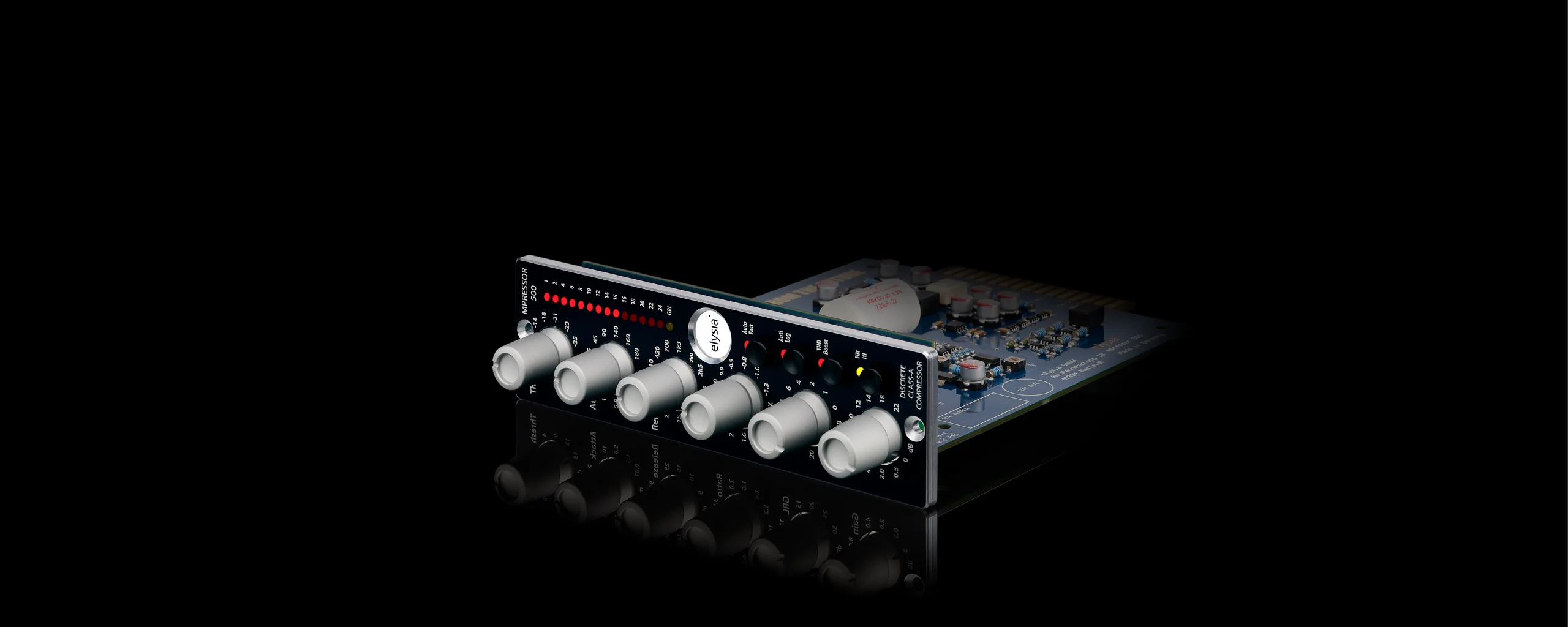

By loading the video, you agree to YouTube's privacy policy.
Learn more

By loading the video, you agree to YouTube's privacy policy.
Learn more

By loading the video, you agree to YouTube's privacy policy.
Learn more
Just like its bigger brother mpressor|500 gets you creative sounds that make your instruments pop!
Choose between different examples including applications like recording, mixing or even mastering, use good headphones or speakers. Just press Play and A/B between the bypassed and active sounds!
Note: All audio is being processed by the analog hardware device.
Featured artists in these examples: Schutzschall, Living Pearls
Note: If you have technical difficulties and don't hear audio playing back, you may want to switch off silent mode on your mobile device.
It is characteristic of a logarithmic release that the time constant shortens when the amount of gain reduction increases. The advantage of this behavior is that short and loud peaks (e.g. drums) have a fast release time, while the remaining material is processed with a slower release time.
But if intentionally striking and creative compression is the goal, it definitely makes sense to turn things upside down. In the Anti Log mode of the mpressor the curve behaves just the other way round: If the threshold value is passed and compression starts, the release time will be longer at the beginning. If the input signal starts to decline, however, the release time will become faster as a result.
Choosing the right time settings is very important, but depending on the dynamic progress of the source material this can be a difficult task – no matter if single tracks or complete mixes are processed. If a very short attack time is chosen, the compressor is able to catch the short peaks, but on the other hand the sustaining signal will also be processed, which might result in audible distortion. Longer settings reduce distortion significantly, but then the compressor is too slow for catching fast impulses. This is where the Auto Fast function comes into play. For example, if you set the attack to 80 ms and then engage the Auto Fast mode, the attack time will be shortened automatically on fast and loud signal impulses. The compressor reduces the signal quickly and prevents it from slipping through.
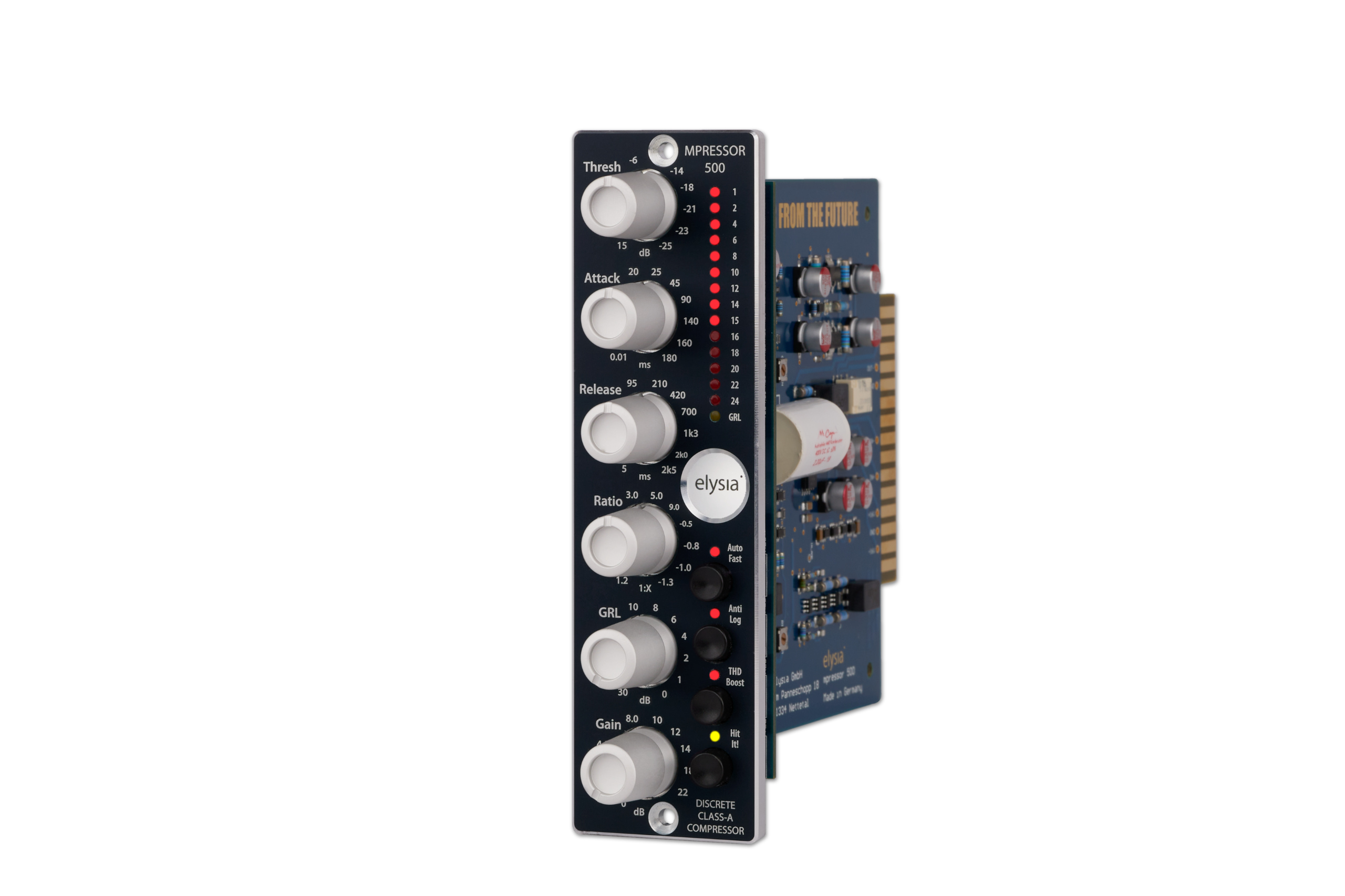
The mpressor|500 is a pure feed forward compressor, and the gain potentiometer is placed before the control element. This means that the intensity of the saturation can be raised or lowered by different settings of the gain controller.
What’s special: The detector in the sidechain of the compressor runs in parallel and is therefore not influenced by the THD Boost at all. The actual compression does not change, it is only the sound which is being influenced.
You generate a saturated signal which as a result is also reduced in dynamics, but the actual control of the compressor itself is always based on the original dynamics including all transients, impulses and so on.
The gain reduction meter is a very important visual tool for evaluating the operation of the compressor in addition to what your ears tell you. The mpressor|500 these uses an analog dynamic variant that combines the benefits of both VU meters and LED chains. This meter is based on LEDs, too, but a special circuit design makes it possible to show intermediate values by modulating the brightness of the LEDs.
This means a true analog way of showing the operation of the compressor: Very fast, but with smooth transitions. The user gets an important tool for precise gain reduction monitoring – finally the relationship between acoustic and visual perception feels just right.
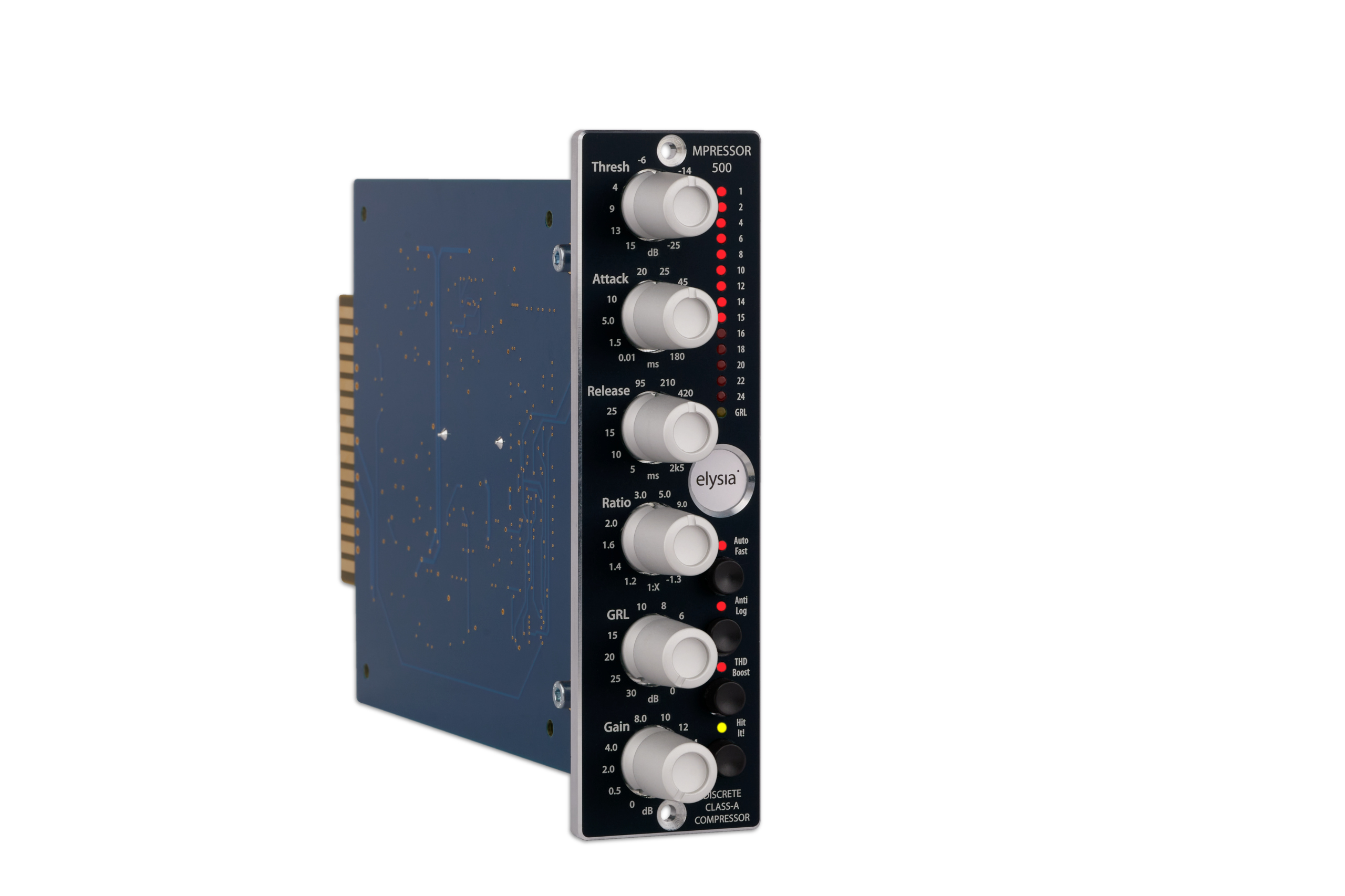
A specialty of the mpressor|500 is the Gain Reduction Limiter for the control voltage.
This limiter is not placed in the audio path where you would usually find it, but in the control path of the compressor. When it is activated, it limits the control voltage according to the setting of the GR Limit controller. This means: No matter how high the input level might become – the amount of gain reduction will never exceed the value which you have set.
Loud parts in an arrangement can keep their dynamics, as they will not be compressed beyond the limit of the Gain Reduction Limiter.
Some very nice special effects like ducking or upward compression can be achieved with this easily by only reducing the quieter parts without changing the original dynamics at the same time.
Negative ratios – what exactly does this mean? To get a better understanding of this function, it makes sense to realize what the ratio control of a ‘normal’ compressor does:
At a negative ratio, the characteristic curve bends and returns back down after crossing the threshold. The louder the input signal, the lower the output signal – perfect for groovy compression effects. To get a grip on the extreme ‘destruction’ this can cause, engaging the Gain Reduction Limiter is just the right idea.
How do you get your favorite analog audio processors side by side of your laptop at home? What about your next tour or gig traveling the world?
We have unleashed our famous elysia analog audio processing hardware to make your musical life much easier, flexible and mobile with the elysia qube series.
A selected series of our famous 500-Analog Modules with Class-A Topology in a rugged, lightweight and travel-ready aluminium case with all the great pristine, transparent sound you will expect from us.
Analog to Go. Everywhere.
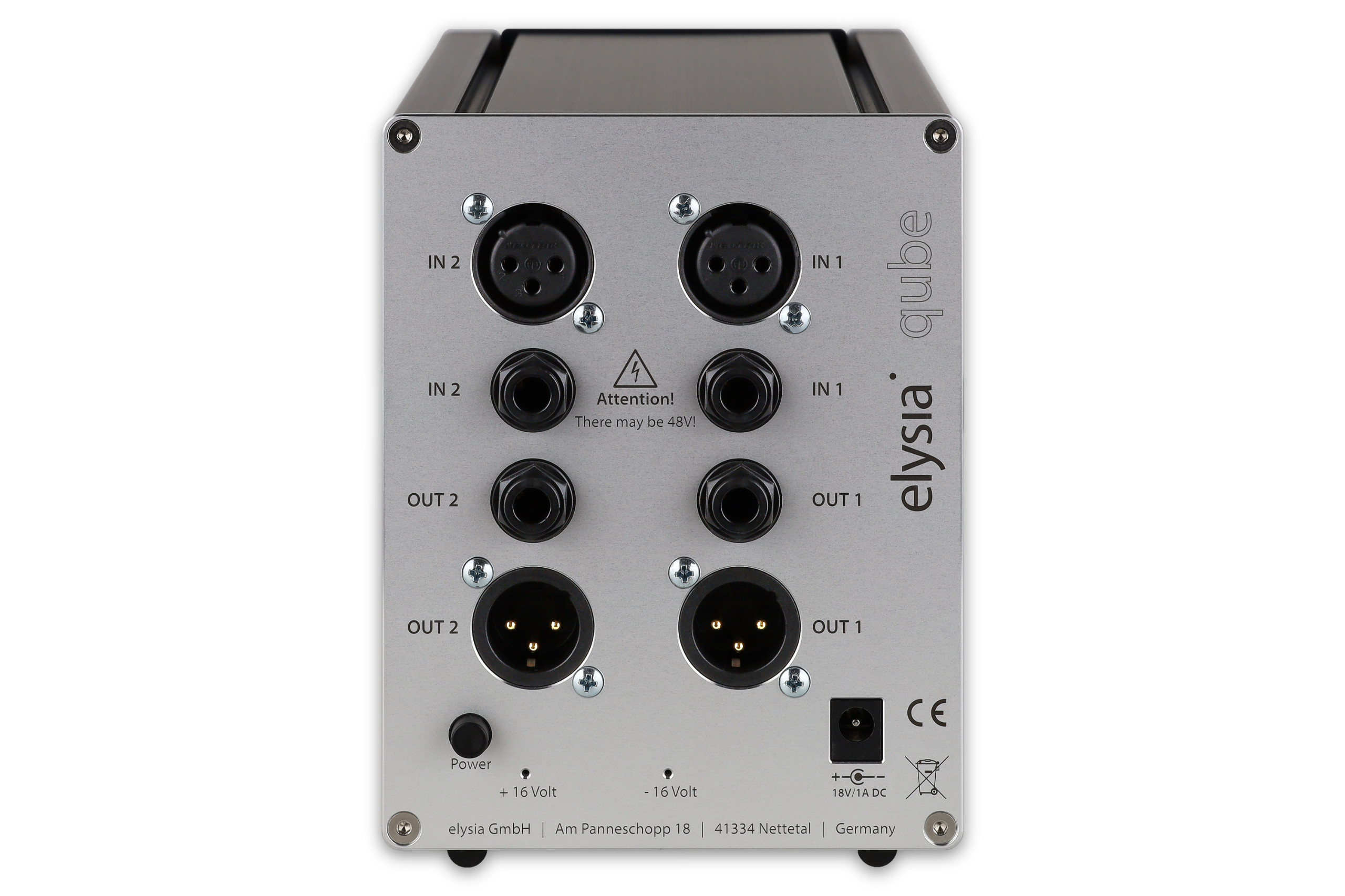
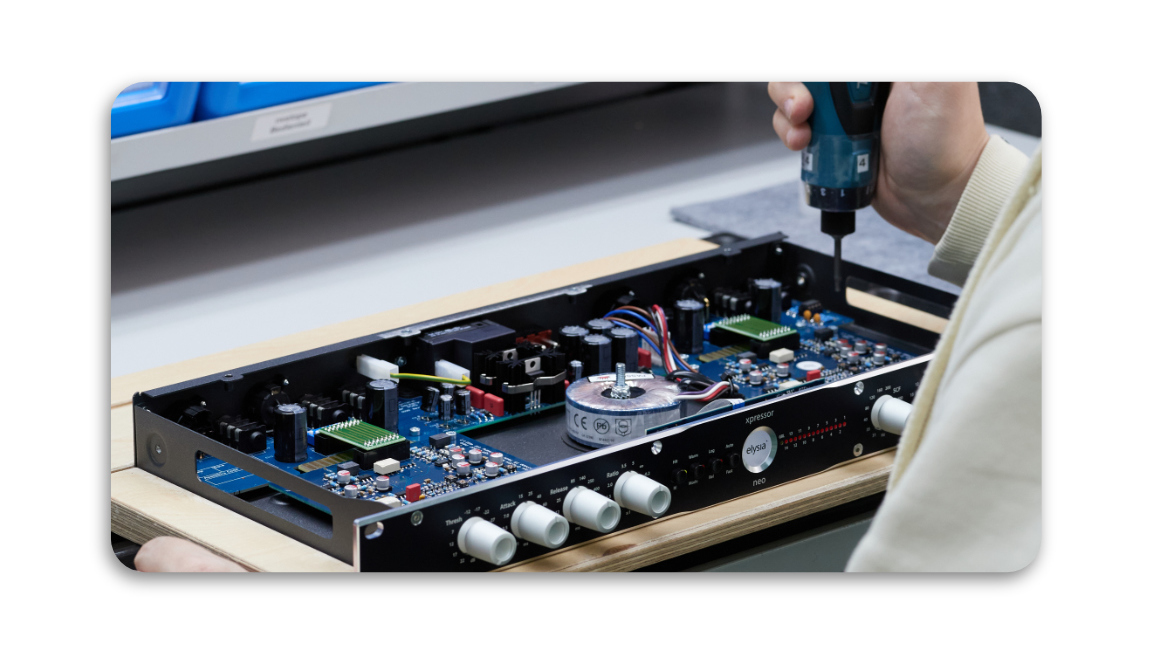
The mpressor plugin is the perfect tool for modern dynamics processing and the emulation of our beloved analog mpressor hardware. In addition to great-sounding standard compression, this compressor provides several creative functions that produce fat sounds with punch, beautiful coloration, and extreme processing effects. The mpressor plugin is equally at home compressing tracks or busses in a mix or while tracking.
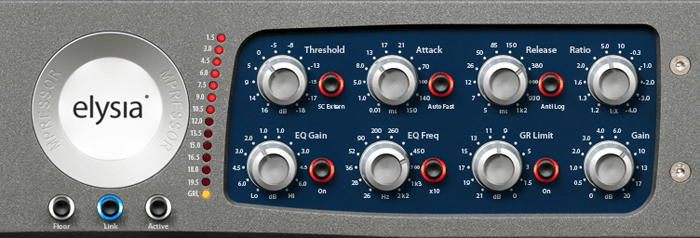
The niveau filter section of our famous mpressor plugin. Add punch to muffled snares, reduce the harshness from active pickups, create some wonderful Dub and LoFi sounds…there are so many ways to benefit from this little tool. It’s fast, efficient, and most important: It sounds great!
This filter is a specialist in changing the overall sonic character of a signal with ease. It features two comprehensive controllers and is capable of producing great results in no time at all. Whenever a classic shelving filter would be too limited and a fully parametric would be too much, the niveau filter is the perfect tool.
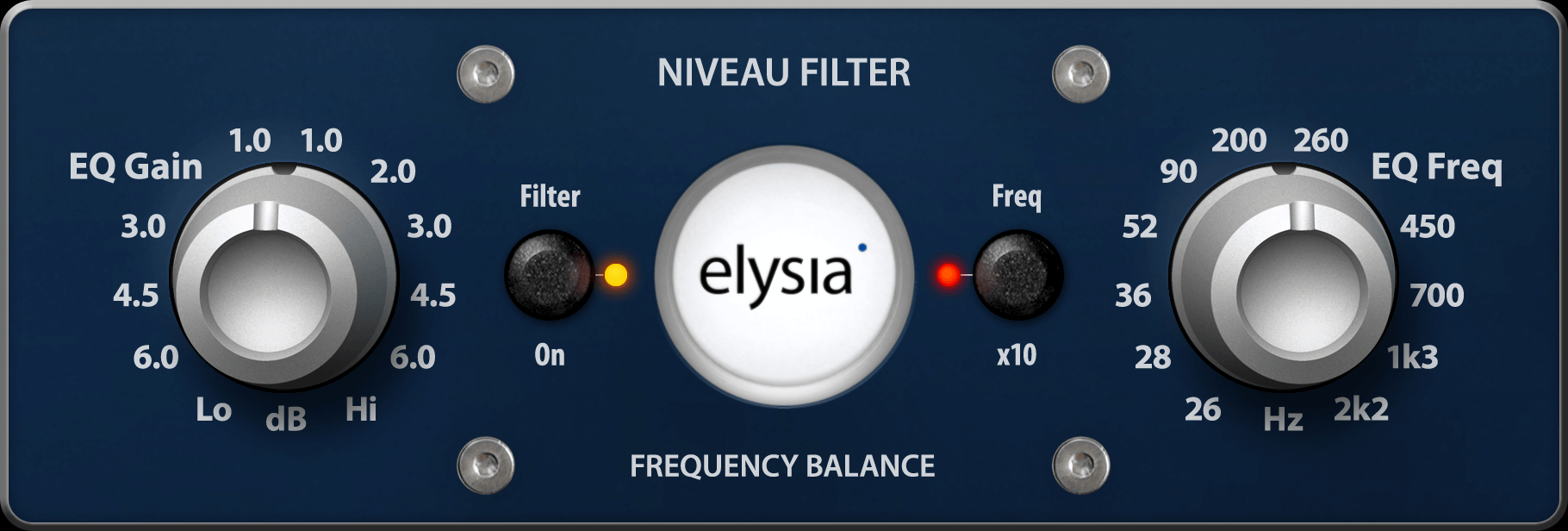
Frequency response:
2 RU Rack:
500 Series Module:
<10 Hz – 33 kHz (-3,0 dB)
<10 Hz – 390 kHz (-3,0 dB)
THD+N @ +0 dBu, 20 Hz – 22 kHz:
2 RU Rack:
500 Series Module:
500 Series Module: (THD Boost):
0,04 %
0,04 %
0,24 %
THD+N @ +10 dBu, 20 Hz – 22 kHz:
2 RU Rack:
500 Series Module:
500 Series Module: (THD Boost):
0,33 %
0,19 %
2,20 %
Noise floor, 20 Hz – 20 kHz (A-weighted):
2 RU Rack:
500 Series Module:
500 Series Module: (THD Boost):
-84 dBu
-79 dBu
-78 dBu
Dynamic range, 20 Hz – 22 kHz:
2 RU Rack:
500 Series Module:
109 dB
99 dB
Maximum input level:
2 RU Rack:
500 Series Module:
+25 dBu
+21 dBu
Maximum output level:
2 RU Rack:
500 Series Module:
+27 dBu
+22 dBu
Impedance:
Input:
Output:
10 kOhm
68 Ohm
Dimensions (W x H x D, incl. Knobs):
2 RU Rack:
elysia qube:
19” x 3,6“ x 15“
483 mm x 90 mm x 380 mm
4,09“ x 5,39“ x 8,1“
104 mm x 137 mm x 205 mm
Weight:
2 RU Rack:
elysia qube:
17,2 lbs / 7,8 kg
3,04 lbs / 1,38 kg
Power consumption:
2 RU Rack:
elysia qube:
500 Series Module
31 Watts (60 W max.)
6 Watts
70 mA
Potentiometers:
2 RU Rack:
elysia qube:
500 Series Module:
21 Steps
41 Steps
41 Steps
With exceptional precision and versatile features, the elysia mpressor empowers you to sculpt your mix with surgical accuracy, from gentle shaping to powerful compression. Achieve a perfectly balanced sonic landscape that elevates every element of your music.
Unleash your creativity with mpressor’s innovative features like the “Anti-Log” release, Tilt EQ or the Gain Reduction Limiter. Craft unique and expressive sounds that stand out from the crowd, adding that elusive touch of magic to your tracks.
Compact yet mighty – Designed for the 500 Series format, the mpressor|500 packs the same audio quality as its larger counterpart, but in a conveniently portable size. This means you can have the legendary elysia sound at your fingertips, even in the most space-limited setups.
Trusted by top producers and engineers worldwide, the mpressor is your secret weapon for achieving professional-grade mixes. Its transparent and musical compression ensures your mixes maintain clarity and punch, adapting seamlessly to any genre or style.
Enjoy an intuitive interface and user-friendly controls, streamlining your workflow to keep you focused on your creativity. Built with top-tier components, the mpressor is reliable and ready to handle your most critical projects.
Copyright @ 2024 elysia GmbH. All rights reserved. Am Panneschopp 18 | 41334 Nettetal | business hours from monday until friday from 9:00 to 17:00h (CET)
We need your consent before you can continue on our website. If you are under 16 and wish to give consent to optional services, you must ask your legal guardians for permission. We use cookies and other technologies on our website. Some of them are essential, while others help us to improve this website and your experience. Personal data may be processed (e.g. IP addresses), for example for personalized ads and content or ad and content measurement. You can find more information about the use of your data in our privacy policy. You can revoke or adjust your selection at any time under Settings.
If you are under 16 and wish to give consent to optional services, you must ask your legal guardians for permission. We use cookies and other technologies on our website. Some of them are essential, while others help us to improve this website and your experience. Personal data may be processed (e.g. IP addresses), for example for personalized ads and content or ad and content measurement. You can find more information about the use of your data in our privacy policy. Here you will find an overview of all cookies used. You can give your consent to whole categories or display further information and select certain cookies.